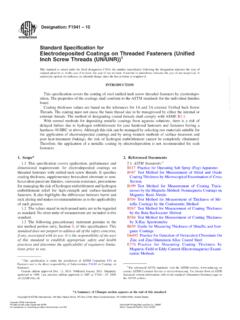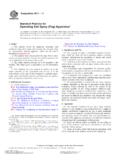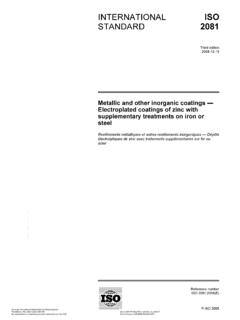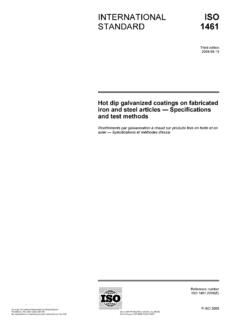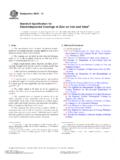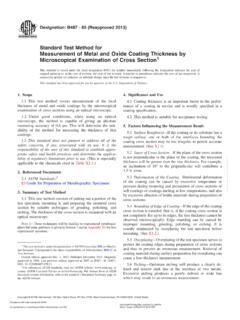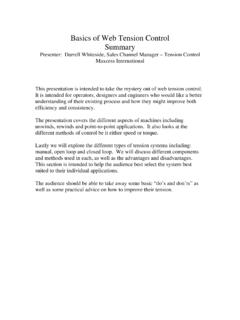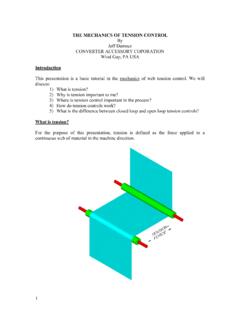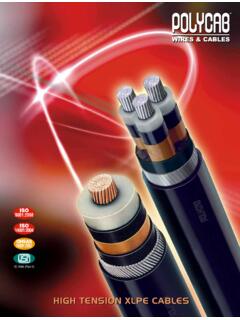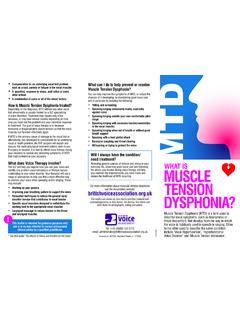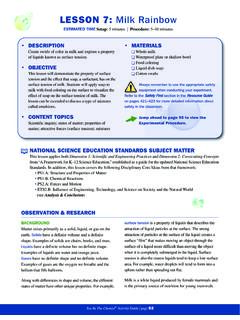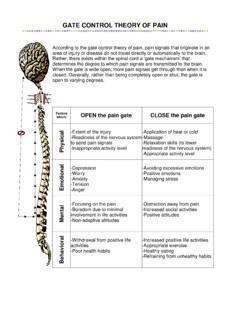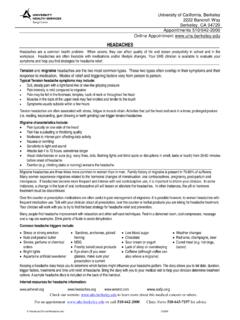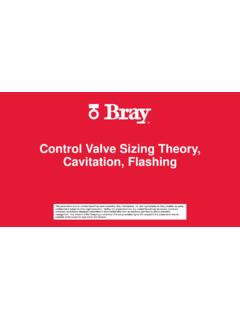Transcription of Standard Test Methods for Tension Testing of Metallic ...
1 Designation: E8/E8M 13aAmerican Association StateHighway and Transportation Officials StandardAASHTO No.: T68An American National StandardStandard Test Methods forTension Testing of Metallic Materials1 This Standard is issued under the fixed designation E8/E8M; the number immediately following the designation indicates the year oforiginal adoption or, in the case of revision, the year of last revision. A number in parentheses indicates the year of last reapproval. Asuperscript epsilon ( ) indicates an editorial change since the last revision or Standard has been approved for use by agencies of the Department of Scope* These test Methods cover the Tension Testing of metallicmaterials in any form at room temperature, specifically, themethods of determination of yield strength, yield pointelongation, tensile strength, elongation, and reduction of The gauge lengths for most round specimens are re-quired to be 4D for E8 and 5D for E8M. The gauge length isthe most significant difference between E8 and E8M testspecimens.
2 Test specimens made from powder metallurgy(P/M) materials are exempt from this requirement by industry-wide agreement to keep the pressing of the material to aspecific projected area and Exceptions to the provisions of these test Methods mayneed to be made in individual specifications or test Methods fora particular material. For examples, see Test Methods andDefinitionsA370and Test MethodsB557, Room temperature shall be considered to be 10 to 38 C[50 to 100 F] unless otherwise The values stated in SI units are to be regarded asseparate from inch/pound units. The values stated in eachsystem are not exact equivalents; therefore each system mustbe used independently of the other. Combining values from thetwo systems may result in non-conformance with the Standard does not purport to address all of thesafety concerns, if any, associated with its use. It is theresponsibility of the user of this Standard to establish appro-priate safety and health practices and determine the applica-bility of regulatory limitations prior to Referenced Standards.
3 2A356/A356 MSpecification for Steel Castings, Carbon, LowAlloy, and Stainless Steel, Heavy-Walled for Steam Tur-binesA370 Test Methods and Definitions for Mechanical Testingof Steel ProductsB557 Test Methods for Tension Testing Wrought and CastAluminum- and Magnesium-Alloy ProductsB557 MTest Methods for Tension Testing Wrought and CastAluminum- and Magnesium-Alloy Products (Metric)E4 Practices for Force Verification of Testing MachinesE6 Terminology Relating to Methods of Mechanical TestingE29 Practice for Using Significant Digits in Test Data toDetermine Conformance with SpecificationsE83 Practice for Verification and Classification of Exten-someter SystemsE345 Test Methods of Tension Testing of Metallic FoilE691 Practice for Conducting an Interlaboratory Study toDetermine the Precision of a Test MethodE1012 Practice for Verification of Testing Frame and Speci-men Alignment Under Tensile and Compressive AxialForce ApplicationD1566 Terminology Relating to RubberE1856 Guide for Evaluating Computerized Data AcquisitionSystems Used to Acquire Data from Universal TestingMachines3.
4 Of Terms Common to Mechanical Testing The definitions of mechanical Testing terms that ap-pear in the TerminologyE6apply to this test test Methods are under the jurisdiction of ASTM CommitteeE28onMechanical Testing and are the direct responsibility of edition approved July 1, 2013. Published August 2013. Originallyapproved in 1924. Last previous edition approved 2013 as E8/E8M 13. referenced ASTM standards, visit the ASTM website, , orcontact ASTM Customer Service at ForAnnual Book of ASTMS tandardsvolume information, refer to the Standard s Document Summary page onthe ASTM website.*A Summary of Changes section appears at the end of this standardCopyright ASTM International, 100 Barr Harbor Drive, PO Box C700, West Conshohocken, PA 19428-2959. United States1 Copyright ASTM International Provided by IHS under license with ASTM Sold to:NW PA Reg Plann and Dev Co, 811794 Not for Resale,09/25/2013 09:03:44 MDTNo reproduction or networking permitted without license from IHS--`````,`,,``,`,,,``,`,```,,,``-`-`,, `,,`,`,,` These terms include bending strain, constraint,elongation, extensometer, force, gauge length, necking, re-duced section, stress-strain diagram, Testing machine, andmodulus of In addition, the following common terms from Termi-nologyE6are yielding, n in a uniaxial test, a hesita-tion or fluctuation of force observed at the onset of plasticdeformation, due to localized The stress-strain curve need not appearto be after fracture, n the elongation measuredby fitting the two halves of the broken specimen at fracture, n the elongation measuredjust prior to the sudden decrease in force associated yield strength, LYS [FL-2]
5 In a uniaxial test,the minimum stress recorded during discontinuous yielding,ignoring transient of area, n the difference between theoriginal cross-sectional area of a Tension test specimen and thearea of its smallest cross The reduction of area is usually ex-pressed as a percentage of the original cross-sectional area ofthe The smallest cross section may be mea-sured at or after fracture as specified for the material under The term reduction of area when ap-plied to metals generally means measurement after fracture;when applied to plastics and elastomers, measurement atfracture. Such interpretation is usually applicable to values forreduction of area reported in the literature when no furtherqualification is given.( ) strength, Su[FL 2],n the maximum tensilestress that a material is capable of Tensile strength is calculated from themaximum force during a Tension test carried to rupture and theoriginal cross-sectional area of the elongation, Elu, [%] the elongation deter-mined at the maximum force sustained by the test piece justprior to necking or fracture, or Uniform elongation includes both elas-tic and plastic yield strength, UYS [FL-2] in a uniaxial test,the first stress maximum (stress at first zero slope) associatedwith discontinuous yielding at or near the onset of point elongation, YPE, n in a uniaxial test, thestrain (expressed in percent) separating the stress-strain curve sfirst point of zero slope from the point of transition fromdiscontinuous yielding to uniform strain If the transition occurs over a rangeof strain, the YPE end point is the intersection between(a)ahorizontal line drawn tangent to the curve at the last zero slopeand(b)
6 A line drawn tangent to the strain hardening portion ofthe stress-strain curve at the point of inflection. If there is nopoint at or near the onset of yielding at which the slope reacheszero, the material has 0 % strength, YSorSy[FL 2],n the engineeringstress at which, by convention, it is considered that plasticelongation of the material has This stress may be specified in termsof (a) a specified deviation from a linear stress-strainrelationship, (b) a specified total extension attained, or (c)maximum or minimum engineering stresses measured duringdiscontinuous of Terms Specific to This test, n test made to settle a disagreement as tothe conformance to specified requirements, or conducted by athird party to arbitrate between conflicting , Significance and Tension tests provide information on the strength andductility of materials under uniaxial tensile stresses. Thisinformation may be useful in comparisons of materials, alloydevelopment, quality control , and design under certain The results of Tension tests of specimens machined tostandardized dimensions from selected portions of a part ormaterial may not totally represent the strength and ductilityproperties of the entire end product or its in-service behavior indifferent These test Methods are considered satisfactory for ac-ceptance Testing of commercial shipments.
7 The test methodshave been used extensively in the trade for this Machines Machines used for Tension testingshall conform to the requirements of PracticesE4. The forcesused in determining tensile strength and yield strength shall bewithin the verified force application range of the testingmachine as defined in Various types of gripping devices may beused to transmit the measured force applied by the testingmachine to the test specimens. To ensure axial tensile stresswithin the gauge length, the axis of the test specimen shouldcoincide with the center line of the heads of the testingmachine. Any departure from this requirement may introducebending stresses that are not included in the usual stresscomputation (force divided by cross-sectional area).NOTE1 The effect of this eccentric force application may be illus-trated by calculating the bending moment and stress thus added. For astandard [ ] diameter specimen, the stress increase is points for each mm [ in.]
8 ] of eccentricity. This errorincreases to percentage points/ mm [ in.] fora9mm[ ] diameter specimen and to percentage points/ mm[ in.] for a 6-mm [ ] diameter Alignment Methods are given in Grips Testing machines usually are equippedwith wedge grips. These wedge grips generally furnish asatisfactory means of gripping long specimens of ductile metalE8/E8M 13a2 Copyright ASTM International Provided by IHS under license with ASTM Sold to:NW PA Reg Plann and Dev Co, 811794 Not for Resale,09/25/2013 09:03:44 MDTNo reproduction or networking permitted without license from IHS--`````,`,,``,`,,,``,`,```,,,``-`-`,, `,,`,`,,`---and flat plate test specimens such as those shown inFig. 1. If,however, for any reason, one grip of a pair advances fartherthan the other as the grips tighten, an undesirable bendingstress may be introduced. When liners are used behind thewedges, they must be of the same thickness and their facesmust be flat and parallel. For best results, the wedges should besupported over their entire lengths by the heads of the testingmachine.
9 This requires that liners of several thicknesses beavailable to cover the range of specimen thickness. For propergripping, it is desirable that the entire length of the serratedface of each wedge be in contact with the specimen. Properalignment of wedge grips and liners is illustrated inFig. 2. Forshort specimens and for specimens of many materials it isgenerally necessary to use machined test specimens and to usea special means of gripping to ensure that the specimens, whenunder load, shall be as nearly as possible in uniformlydistributed pure axial Tension ( , , ). for Threaded and Shouldered Specimens andBrittle Materials A schematic diagram of a gripping devicefor threaded-end specimens is shown inFig. 3, whileFig. 4shows a device for gripping specimens with shouldered of these gripping devices should be attached to the headsof the Testing machine through properly lubricated spherical-seated bearings. The distance between spherical bearingsshould be as great as for Sheet Materials The self-adjusting gripsshown inFig.
10 5have proven satisfactory for Testing sheetmaterials that cannot be tested satisfactorily in the usual type ofwedge for Wire Grips of either the wedge or snubbingtypes as shown inFig. 5andFig. 6or flat wedge grips may Devices Micrometers and otherdevices used for measuring linear dimensions shall be accurateand precise to at least one half the smallest unit to which theindividual dimension is required to be Extensometers used in Tension testingshall conform to the requirements of PracticeE83for theclassifications specified by the procedure section of this testmethod. Extensometers shall be used and verified to includethe strains corresponding to the yield strength and elongation atfracture (if determined). Extensometers with gauge lengths equal to or shorterthan the nominal gauge length of the specimen (dimensionshown as G-Gauge Length in the accompanying figures) maybe used to determine the yield behavior. For specimens withouta reduced section (for example, full cross sectional areaspecimens of wire, rod, or bar), the extensometer gauge lengthfor the determination of yield behavior shall not exceed 80 %of the distance between grips.
